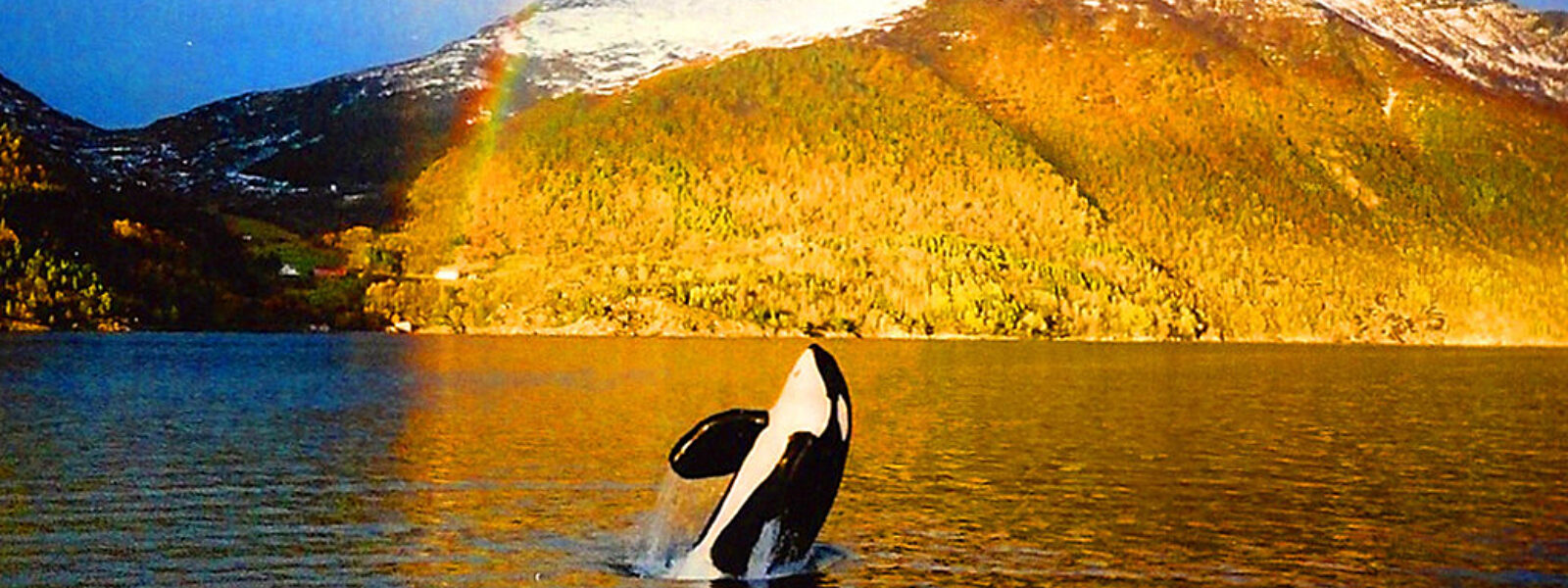
“Free Willy” Paved the Way to Ending Whale Captivity (Part 3 of 3)
By Hannah Hindley
Hannah Hindley is a naturalist, science writer, and conservationist. She is the recipient of the Barry Lopez Prize in Nonfiction, the Ellen Meloy Desert Writers Award, and the Thomas Wood Award in Journalism, among other honors – see more of her work at hannahhindley.com. She often spends summers among the wild whales in Alaska, working as a wilderness guide.
SANCTUARY / THE FINAL CHAPTER
When Warner Bros. began fielding agitated phone calls after the release of Free Willy, Keiko’s friends from around the world began offering solutions. One little girl, in particular, had an exceptional idea: she wrote from Nova Scotia, where her family lived on the shores of “a beautiful, deep, sheltered cove” – a perfect refuge for a recovering whale. Corinne Goyetche used a green pencil to scrawl commentary across maps, depth charts, fisheries data, and freshwater discharge tables, all of which she mailed off to IMMP and the Free Willy/Keiko Foundation. Liberating a captive whale was complicated business.
But rather than Nova Scotia, Keiko made it all the way to his home in the wild waters of Iceland instead.

Keiko's seaside sanctuary in Iceland. Photo Credit: Free Willy/Keiko Foundation
Corinne’s idea had true merit. Keiko spent about three years living in a cove in Iceland’s Westman Islands in a seaside sanctuary netted off from the ocean, very similar to Corinne’s idea. He was fed and received veterinary care. He was taught to follow a guide boat on “walks” out on the open ocean, to swim with wild orca pods.
And eventually, he swam free.
Today, seaside sanctuaries might be the solution that finally cracks the dilemma of how to safely and humanely give freedom to the world’s captive whales. Think of it as a retirement plan: healthy dolphins and whales that were captured from the wild have the chance to be fully released into their wild home waters. Those born in captivity or contending with health issues leaving them little chance of being able to feed themselves or survive the rigors of open water shouldn’t be left behind either. A netted-off bay, with veterinary care and food provided, would allow animals the chance to live out their lives in freedom rather than in tanks – to be able to feel the rise and fall of the tides, to dive deep into strong, cold currents . . . possibly even to hear the voices of long-lost families in the ocean beyond.
“What was once thought impossible is now within reach.”
It’s more than an optimistic idea. The tide is turning. In 2020, in the very same bay where Keiko was first returned to Iceland, two beluga whales named Little White and Little Gray made history as the first belugas to be freed from a concrete tank. Their sea pen in Klettsvik Bay serves as a model for rehoming the other 300 belugas currently in tanks. Other sea sanctuaries are being created elsewhere, too: the Whale Sanctuary Project, co-founded by Dave Phillips, Director of the International Marine Mammal Project (IMMP), seeks to provide freed whales an enclosed part of the ocean in Nova Scotia, far bigger than the world’s biggest aquarium. In Greece, the Aegean Marine Life Sanctuary will soon become the first permanent sanctuary for warm-water dolphins in the world. All that remains is to call for an end to captivity.

Keiko at last swam free in his home waters. Critics complain that since Keiko died, the effort was a failure. But when Keiko died, he was the second oldest male orca ever kept in captivity. Many captive orcas died during the time Keiko was being rehabilitated and swimming free in Iceland. Photo Credit: Free Willy/Keiko Foundation
Momentum is building. In March, the Miami Seaquarium made a historic announcement that they would be returning the 56-year-old orca Lolita – also known as Tokitae – to an undisclosed sea sanctuary in her home waters of the Pacific Northwest. Public interest continues to build, too – this fall, the award-winning podcast Serial plans to tell the true story of Keiko, 30 years after Free Willy. Believers in whale sovereignty continue to push Congress to pass the SWIMS Act, a federal law endorsed by IMMP, which would phase out captivity of orcas, belugas, pilot whales and false killer whales by banning imports, exports, and breeding in captivity.
As public and political sentiment shift, Dave Phillips thinks we might truly be close to ending whale captivity forever: “What was once thought impossible,” he says, “is now within reach.”
Thirty years later, people still call the 800 number at the end of Free Willy. “Thank you,” they say, “it still gives me chills” and “it really impacted my life.” Some callers chose to become marine biologists after seeing the movie. Others, who watched it as children, now show it to their kids and dial up the number together with them: “My son and I are in tears,” they say, and “Save the whales!”
As change sweeps over the captive whale industry, we are on the brink of a Free Willy “sequel” – maybe even a final chapter, in the wake of Free Willy and Blackfish . . . not on screen this time, but in real life. A movie poster of the real-world sequel might star not just an orca leaping the breakwater toward freedom, but feature all the whale species that have been confined.
“Free Them All,” the title might read.
We’re close, but not there yet. Will you tell the story alongside us?
*********************************************
Hear Dave Phillips’ discussion of Keiko with BBC Radio.
*********************************************
